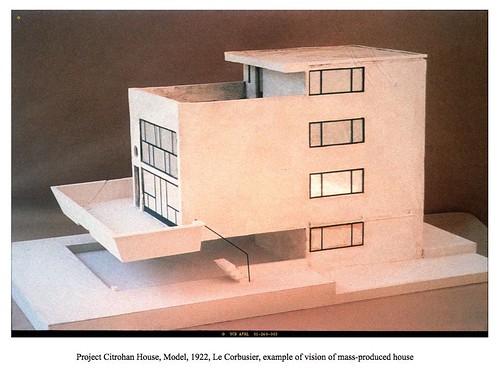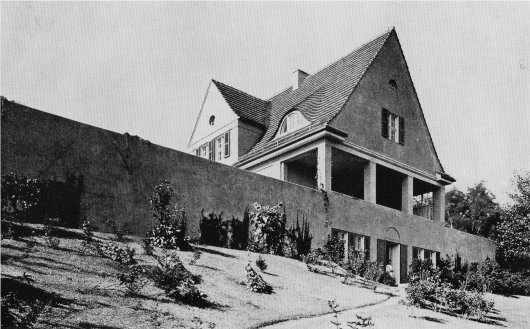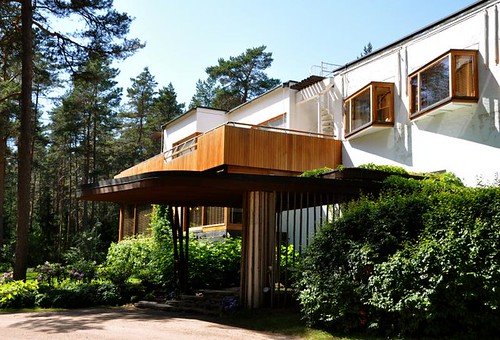Probably some of the most important names in Architecture during the 20th century were that of Le Corbusier, Mies Van der Rohe, and Alvar Aalto. Particularly in their residential houses, their designs defined key ideas in modern architecture. This writing will look at the approaches of each architect in the designs for their residential projects and also look at how those ideas changed over time.
In his early career, Le Corbusier was very much influenced by work going on at the time by the Deutscher Werkbund and figures such as Adolf Loos who stood for the idea that “ornament is crime”. Le Corbusier was very much a part of the L’Esprit Nouveau going on in France which sought to clear the relationship between art and industrial society. From this Le Corbusier took the ideas that industrialism in modern society was leading towards collectivism (Le Corbusier displayed many socialist ideas in later projects). He also seized the idea that the machine had the ability to “display proportions of volume and material” which would in turn create order; something modern industrial society was looking for. Another influence for Le Corbusier was the work of Cubist artists at the time. Le Corbusier praised Cubism for “its abolition of narrative, its simplification of forms, and its method of selecting certain objects as emblems of modern life” (Colquhoun 140).
Model of the Citrohan House- Le Corbusier http://farm4.static.flickr.com/3154/3444735387_1c383c88b0.jpg
In Le Corbusier’s Citrohan House (1925), he is using industrialization in the form of prefabricated floor plates and columns, an idea first formulated in his Dom-ino frame (1914). The walls of the house serve a non-structural purpose but begin to fill in between columns and form spaces. The house becomes a simple cubic volume where its structure and tectonics are disguised. Le Corbusier modeled the house in the likeness of Citrohan racing cars where “like the machinery of a car, the technology of the house should be invisible” (Colquhoun 146). It was from the design of this house that led Le Corbusier to publish his 5 points of Architecture that would become a rule system for his future projects.
Villa Savoye- Le Corbusier
Perhaps the most well-known example of Le Corbusier’s 5 points is the Villa Savoye done in 1931. In it he uses the pilotis, roof garden, free plan, free façade, and ribbon windows. With all of these elements set down in the beginning, Le Corbusier went through a systematic process of incorporating these characteristics so that the end result would be perfected to convey the best sense of order. This work could be compared to an almost neoclassical approach to order; a style that greatly influenced Le Corbusier.
Drawing-facade of Villa Roche with regulating lines- Le Corbusier
Le Corbusier was also known for using his proportion systems (like the Modulor) along with the golden section to inform the composition of his projects. Another approach Le Corbusier took for the design of his building facades was the use of regulating lines. These proportional and mathematical methods were similar to the process in creating machinery. The Maison la Roche is a prime example of how Le Corbusier used proportion and line to arrange his façade.
Le Corbusier's Modulor
http://www.galeriedesign.com/images/modulorMan.jpg
Similar to Le Corbusier, Mies Van der Rohe was surrounded by ideas and figures of the Werkbund and Constructivist movements. And like Le Corbusier, Mies was also influenced by neoclassical and eclectic thought. This is evident in one of his early projects; the Riehl House built in 1907. His Riehl house is very symmetrical, prism-like structure, with a gable end placed on a retaining wall.
Riehl House - Mies Van der Rohe
http://www.plataformaarquitectura.cl/wp-content/uploads/2008/07/459634239_casa-riehl-1907.jpg
It was after World War I that Mies began to apply a more constructivist approach to his design. His houses become more like fragmented planes whose plans almost resemble a Mondrian piece in basic outline. There were two ideas that Mies began to stick with, the first being that enclosure should be generalized to the form of a cubic container and not restricted to any specific function, and second, that a building should respond to the fluidity of life. In the Wolf House (1925), Mies uses a series of interlocking cubes to form a sequence between spaces, almost like a flowing and unrestricted stage for function. Mies also explores the use of material by incorporating brick not only into the cubic structure but also for the terraces outside.
Wolf House- Mies Van der Rohe
http://www.ifa.de/uploads/tx_ifafreebox/resize_mies_guben01_01.jpg
The Tugendhat House built in 1928 marked a transition for Mies. Like many other modern houses at that time, Mies uses a simple geometric form in white. The interior plays with flexibility of space by using screen planes to divide living room space. Mies really experiments with opening up the wall plane by using floor to ceiling windows that look out into the landscape; an idea that translates to his Farnsworth House.
Tugendhat House - Mies Van der Rohe
The Farnsworth really stands as the symbol to his statement that “less is more”. He uses very simple geometry and overlapping planes along with enclosure consisting of entirely floor to ceiling windows. This was insight into nature for Mies to design such a transparent structure, especially for something as private as a house.
Farnsworth House- Mies Van der Rohe
http://3.bp.blogspot.com/_IxttN3npY3o/TTpIG81tZrI/AAAAAAAAAOQ/0REjNmmwVsQ/s1600/2+mies_farnsworth-house_blog.jpg
Another important player in modern architecture was Alvar Aalto. Aalto was again influenced by neoclassical and rationalist thought. However, for Aalto this led him to a New Objectivity and a more modern way of looking at architecture. Aalto was a influenced by functionalism and was also a proponent for the synthesis of form, material, functionality, and aesthetics.
Villa Mairea- Alvar Aalto
http://farm3.static.flickr.com/2668/3758595434_99085ddc57.jpg
As an “experimental house” (Curtis 346), the Villa Mairea gave Aalto the chance to express his new ideas. This house represented a strong connection to nature and a strong sense of regionalism being built with Finnish vernacular tradition in mind. Aalto wrote that “Architecture cannot disengage itself from natural and human factors; on the contrary, it must never do so…. Its function rather is to bring nature ever closer to us” (Curtis 346). For materials Aalto used a pallete of local wood, stone, and brick. Looking at the floor plan, Aalto steers away from “machinism” in favor of a more natural organization. This further exemplifies his stance on connection to nature and begins a movement away from functionalism; something that gives architecture the impetus to move away from classicism and on towards being truly modern.
Experimental house- Alvar Aalto
https://blogger.googleusercontent.com/img/b/R29vZ2xl/AVvXsEht4L03ppe75kzT312gpXTOfVcI7KugbkGSQuOpXug4990MgOWto0L8a86WCElBiWnR3XER0XszYktj7kMqtSHhqTDIPnhmYPpzZAxtind8QC-4MrcTHhI9lhJw-MOEIYQ4ITmDwkaysL0/s1600/4841412000_b6c813a945_o.jpg
Another project that embraces nature is Aalto’s Experimental House (1952) in Muuratsalo, Finland. This was very much an introverted house with a white painted exterior and brick laid central courtyard. Aalto really tried to experiment with the material of brick as he incorporated nearly 50 different brick patterns into the interior of the courtyard. Site, material, climate, and landscape were all very important to Aalto, which became a reoccurring theme in his work.










The separate discussion of each architect and his evolution over time is very good. The paragraph about Mies as a constructivist is very intriguing. Think about directly comparing the three architects more. Good work.
ReplyDeleteVery brief but very telling points. Congratulations.
ReplyDeleteI loved as much as you will receive carried out right here. The sketch is attractive, your authored material stylish. nonetheless, you command get got an nervousness over that you wish be delivering the following. unwell unquestionably come further formerly again since exactly the same nearly very often inside case you shield this increase. top atlanta residential architects
ReplyDelete